mestranol
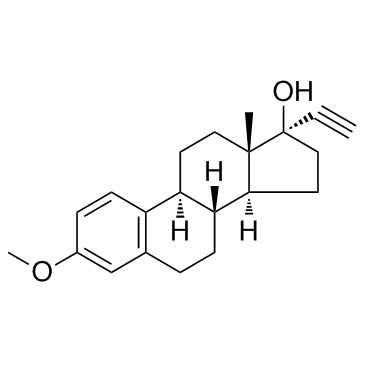
mestranol structure
|
Common Name | mestranol | ||
|---|---|---|---|---|
| CAS Number | 72-33-3 | Molecular Weight | 310.430 | |
| Density | 1.2±0.1 g/cm3 | Boiling Point | 442.3±45.0 °C at 760 mmHg | |
| Molecular Formula | C21H26O2 | Melting Point | 153-155 °C(lit.) | |
| MSDS | Chinese USA | Flash Point | 190.8±23.0 °C | |
| Symbol |


GHS07, GHS08 |
Signal Word | Warning | |
Use of mestranolMestranol is the 3-methyl ether of ethinylestradiol. It was the estrogen used in many of the first oral contraceptives.Target: Estrogen Receptor/ERRMestranol is absorbed very rapidly from the digestive tract and maximum plasma levels are attained in 1-4 hours, the majority at 1-2 hours. Detectable levels of mestranol are present 24 hours postingestion in 58% of subjects after a 50 μg dose and in 79% after a 100 μg dose. At all dose levels, highest plasma mestranol levels and area under the curve of plasma levels (AUC) occurred in Sri Lankan women, and lowest plasma levels in Nigerian women, even when corrected for body surface differences [1]. |
| Name | mestranol |
|---|---|
| Synonym | More Synonyms |
| Description | Mestranol is the 3-methyl ether of ethinylestradiol. It was the estrogen used in many of the first oral contraceptives.Target: Estrogen Receptor/ERRMestranol is absorbed very rapidly from the digestive tract and maximum plasma levels are attained in 1-4 hours, the majority at 1-2 hours. Detectable levels of mestranol are present 24 hours postingestion in 58% of subjects after a 50 μg dose and in 79% after a 100 μg dose. At all dose levels, highest plasma mestranol levels and area under the curve of plasma levels (AUC) occurred in Sri Lankan women, and lowest plasma levels in Nigerian women, even when corrected for body surface differences [1]. |
|---|---|
| Related Catalog | |
| References |
| Density | 1.2±0.1 g/cm3 |
|---|---|
| Boiling Point | 442.3±45.0 °C at 760 mmHg |
| Melting Point | 153-155 °C(lit.) |
| Molecular Formula | C21H26O2 |
| Molecular Weight | 310.430 |
| Flash Point | 190.8±23.0 °C |
| Exact Mass | 310.193268 |
| PSA | 29.46000 |
| LogP | 5.17 |
| Vapour Pressure | 0.0±1.1 mmHg at 25°C |
| Index of Refraction | 1.591 |
| Storage condition | -20°C Freezer |
CHEMICAL IDENTIFICATION
HEALTH HAZARD DATAACUTE TOXICITY DATA
MUTATION DATA
|
| Symbol |


GHS07, GHS08 |
|---|---|
| Signal Word | Warning |
| Hazard Statements | H315-H319-H351 |
| Precautionary Statements | P280-P305 + P351 + P338 |
| Personal Protective Equipment | Eyeshields;full-face particle respirator type N100 (US);Gloves;respirator cartridge type N100 (US);type P1 (EN143) respirator filter;type P3 (EN 143) respirator cartridges |
| Hazard Codes | Xn: Harmful; |
| Risk Phrases | R36/37/38;R40;R48 |
| Safety Phrases | S22-S26-S36/37/39-S45-S36/37 |
| RIDADR | 2811.0 |
| WGK Germany | 3 |
| RTECS | RC8960000 |
|
~92% 
mestranol CAS#:72-33-3 |
| Literature: Wong, Fung Fuh; Chuang, Shih Hsien; Yang, Sheng-chuan; Lin, Yu-Hsiang; Tseng, Wen-Che; Lin, Shao-Kai; Huang, Jiann-Jyh Tetrahedron, 2010 , vol. 66, # 23 p. 4068 - 4072 |
|
~82% 
mestranol CAS#:72-33-3 |
| Literature: Choudhary, Muhammad Iqbal; Musharraf, Syed Ghulam; Siddiqui, Zafar Ali; Khan, Naik Tameen; Ali, Rahat Azhar; Atta-ur-Rahman Chemical and Pharmaceutical Bulletin, 2005 , vol. 53, # 8 p. 1011 - 1013 |
|
~% 
mestranol CAS#:72-33-3 |
| Literature: Journal of the American Chemical Society, , vol. 79, p. 1123,1126 |
| Precursor 5 | |
|---|---|
| DownStream 9 | |
|
Cheminformatics analysis of assertions mined from literature that describe drug-induced liver injury in different species.
Chem. Res. Toxicol. 23 , 171-83, (2010) Drug-induced liver injury is one of the main causes of drug attrition. The ability to predict the liver effects of drug candidates from their chemical structures is critical to help guide experimental... |
|
|
Translating clinical findings into knowledge in drug safety evaluation--drug induced liver injury prediction system (DILIps).
J. Sci. Ind. Res. 65(10) , 808, (2006) Drug-induced liver injury (DILI) is a significant concern in drug development due to the poor concordance between preclinical and clinical findings of liver toxicity. We hypothesized that the DILI typ... |
|
|
Developing structure-activity relationships for the prediction of hepatotoxicity.
Chem. Res. Toxicol. 23 , 1215-22, (2010) Drug-induced liver injury is a major issue of concern and has led to the withdrawal of a significant number of marketed drugs. An understanding of structure-activity relationships (SARs) of chemicals ... |
| (17b)-17-ethynyl-3-methoxyestra-1,3,5(10)-trien-17-ol |
| SC 4725 |
| d-MVE |
| EE3ME |
| 8027 C. B. |
| Ovastol |
| Estra-1,3,5(10)-trien-17β-ol, 17-ethynyl-3-methoxy- |
| 17a-Ethynylestradiol 3-Methyl Ether |
| 19-Norpregna-1,3,5(10)-trien-20-yn-17-ol, 3-methoxy-, (17α)- |
| EINECS 200-777-8 |
| 17a-Ethynyl-1,3,5(10)-estratriene-3,17b-diol 3-methyl ether |
| Devocin |
| (17a)-3-Methoxy-19-norpregna-1,3,5(10)-trien-20-yn-17-ol |
| Estra-1(10),2,4-trien-17-ol, 17-ethynyl-3-methoxy-, (17β)- |
| RS 1044 |
| δ-MVE |
| (17α)-3-Methoxy-19-norpregna-1(10),2,4-trien-20-yn-17-ol |
| (8R,9S,13S,14S,17R)-17-éthynyl-3-méthoxy-13-méthyl-7,8,9,11,12,13,14,15,16,17-décahydro-6H-cyclopenta[a]phénanthrén-17-ol |
| (8R,9S,13S,14S,17R)-17-Ethinyl-3-methoxy-13-methyl-7,8,9,11,12,13,14,15,16,17-decahydro-6H-cyclopenta[a]phenanthren-17-ol |
| mestranol |
| Norquen |
| 17a-Ethynyl-3-methoxy-1,3,5(10)-estratrien-17b-ol |
| MFCD00003689 |
| estra-1,3,5(10)-trien-17-ol, 17-ethynyl-3-methoxy-, (17b)- |
| 17α-Ethynylestradiol 3-methyl ether |
| 3-Methoxy-19-nor-17α-pregna-1,3,5(10)-trien-20-yn-17-ol |


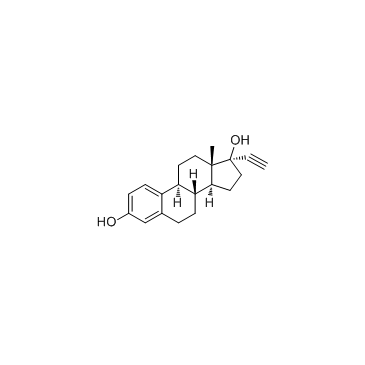


![(8S,9S,13S,14S)-17-ethynyl-3-methoxy-13-methyl-7,8,9,11,12,14,15,16-octahydro-6H-cyclopenta[a]phenanthrene-2,17-diol structure](https://image.chemsrc.com/caspic/269/26011-40-5.png) CAS#:26011-40-5
CAS#:26011-40-5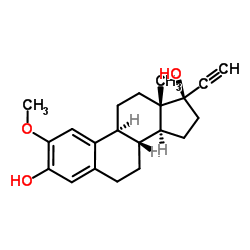 CAS#:22415-44-7
CAS#:22415-44-7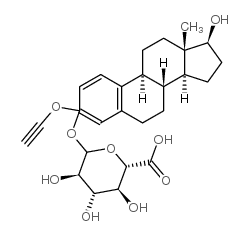 CAS#:60134-76-1
CAS#:60134-76-1 CAS#:75803-39-3
CAS#:75803-39-3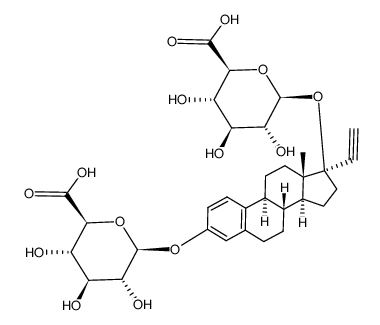 CAS#:75812-41-8
CAS#:75812-41-8![[(8R,9S,13S,14S)-17-ethynyl-3-methoxy-13-methyl-7,8,9,11,12,14,15,16-octahydro-6H-cyclopenta[a]phenanthren-17-yl] acetate structure](https://image.chemsrc.com/caspic/336/10382-22-6.png) CAS#:10382-22-6
CAS#:10382-22-6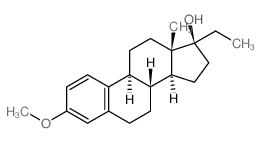 CAS#:17550-03-7
CAS#:17550-03-7
